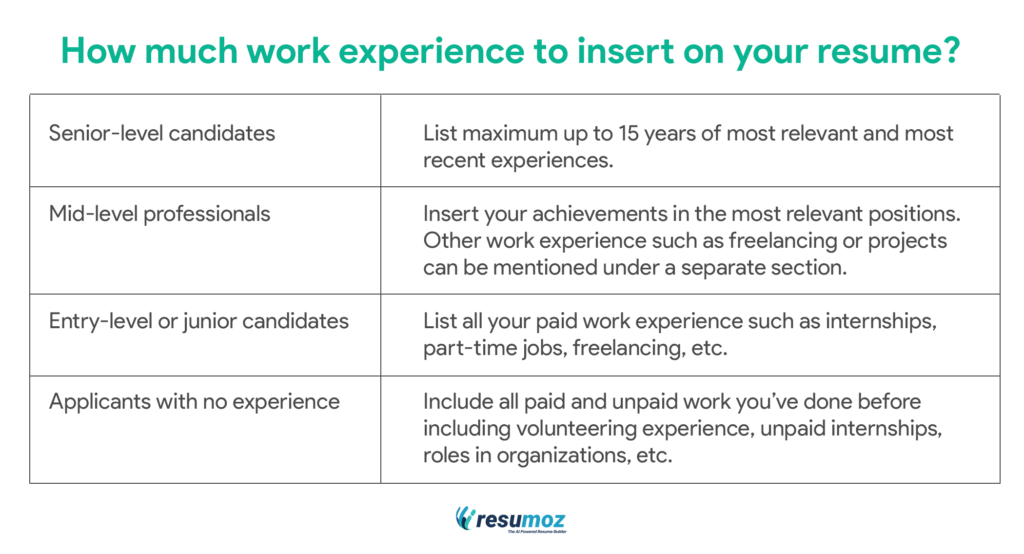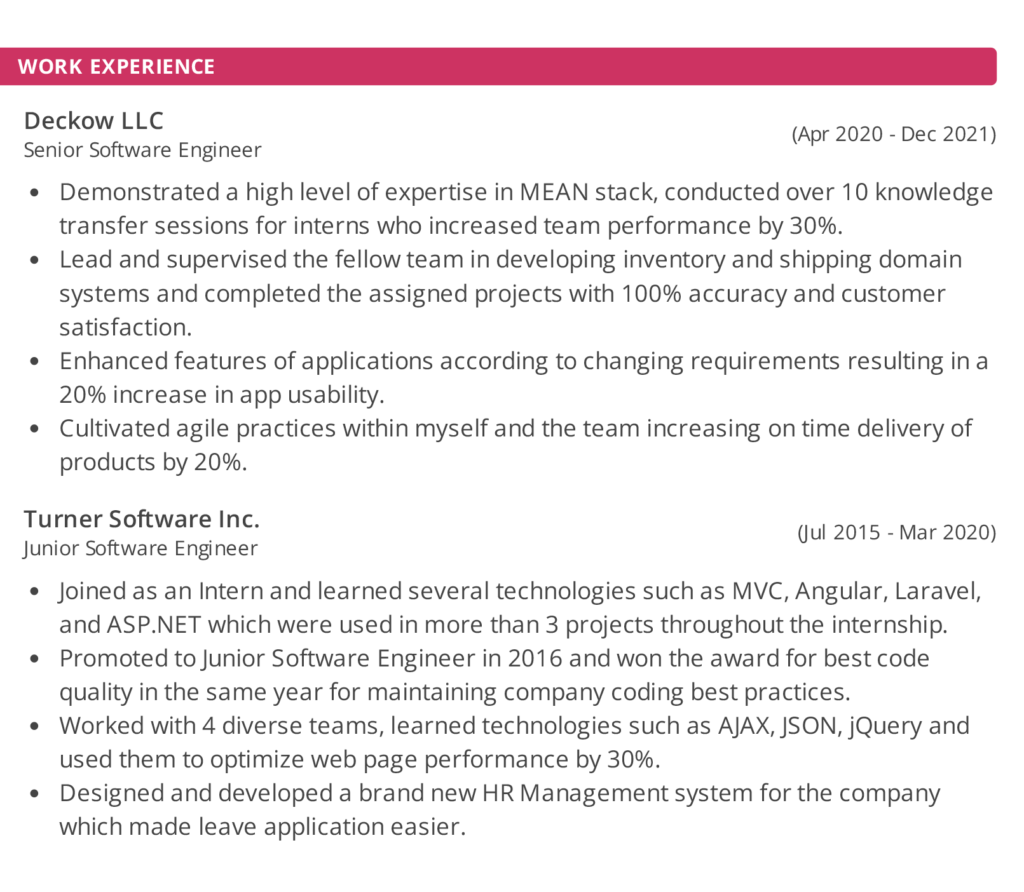The resume work experience section is one of the key sections in a winning resume. Also, the employment history is a section that attracts the attention of many recruiters. Therefore, you need to know how to write a resume work history properly to gain a perfect resume in 2022.
What is a resume work experience section?
The work experience section of a resume is a detailed summary of your accomplishments in your previous career. Via this section employers can see what kind of jobs you have held before and what are accomplishments you achieved.
Depending on your level of experience, you can insert full-time positions, part-time jobs, internships as well as volunteer experiences inside the resume employment history section.
It should include your key accomplishments throughout your career under different job titles. So that the recruiters can get an idea about your potential.
The resume work experience section is also referred to as employment history and work history.

Why do we need a resume work history section in 2022?
Your resume work experience section is the core of your resume. When someone thinks about a resume, the first thing that comes to his/her mind is work experience. Based on the information you provided in this section the employers will determine whether you are suitable for the job or not.
According to recent research, it shows that employers are most likely to read the work experience section first in a typical resume. So a properly written work history section will be a key for you to moving forward in the hiring process. Not only that but also this will distinguish you from other applicants if you were able to list your key relevant achievements effectively.
What is the ideal place to locate your work experience section?
We recommend you should insert your work experience section right after your resume header and the professional summary.
However, if you are a student, recent graduate or a person with no experience or else you are writing an academic CV, you need to put your education first.
How far back should your employment history section go?
This question relies on your level of experience. Take a look at the below table.

When writing your work experience section, a common mistake done by most of the candidates is mentioning every single experience in their resume. This will unnecessarily lengthen your resume and also make your resume irrelevant to the job.
Therefore, always be sure to insert previous work experience which at least gives you a little push to the opportunity you are looking for.
But note that some higher positions require you to have at least 20 years of experience. In such situations, do not limit your experience to 15 years. If a job requires a particular amount of experience, you must include what recruiters are looking for.
What employers are looking for in your resume work experience?
There are some pieces of information that every recruiter wishes to see in your resume employment history section. We can list them as below.
•
Job title/position
•
Company name and location
•
Dates employed
•
Quantified Achievements
•
Promotions
Job titles / positions: Be specific when you write your job title under work history. And also avoid using acronyms to refer to your positions. For example, if you were an SEO specialist you could write it as Search Engine Optimization Specialist instead. Also, some companies define their job titles by creative and fancy names such as Tech Guru, Code Ninja, etc. But we recommend if you hold such a position in your previous careers, mention the standard titles they represent. Because that will mislead and confuse the recruiters as well as the applicant tracking systems.
Company location: Include just the city and state of the company or organization you have worked with before. It is not necessary to mention the complete physical address.
Dates employed: When you insert the employment dates use the standard month-year format. But if you have a considerable employment gap in your career you can simply eliminate the months for your goodness.
Quantified achievements: Concisely describe a few of your relevant accomplishments with the skills you demonstrated and the impact you caused by utilizing quantified results.
Promotions: Your prospective employer loves to see your upward career progression. Therefore it’s cool if you can show any promotion you have earned in your previous positions. So that your potential employer will have an idea that you have performed well in your past roles.
How to list resume experience the right way in 2022
01. Label the section with a standard title
Remember that your resume goes through an ATS before it goes to a recruiter’s hand. Therefore to get past the ATS scan you should not confuse it. That’s why you need to provide clear section titles. Here are some clear section title examples you can use in your work experience section. Also, make all letters capital as it will clearly be visible for the human eye too.
•
WORK EXPERIENCE
•
CAREER HISTORY
•
EMPLOYMENT HISTORY
•
PROFESSIONAL EXPERIENCES
02. List work experience in reverse-chronological format
This means you need to list your current or most recent work experience first and then the others.
By doing so, you put your best foot forward, which means your most recent job with the most experiences gets the most attention from the recruiter.
However, it is up to you to pick the right resume format depending on your experience level. The combination resume format is ideal for candidates with less amount of experience while the reverse-chronological format is perfect for experienced applicants.
03. Write achievement bullet points. Not your job responsibilities
The best way to summarize your job experience is to list down achievement bullet points. It is important to present a summary of the achievements you have made under each of your experiences. Include at least 3 to 5 of your achievements per job.
Often recruiters know your duties and responsibilities in a typical job as soon as they know your job title. Because they are specialists in careers. So instead of presenting job responsibilities, describe the positive impact you have made on the organization through your role.
Take a look at the example below.
Good Example
Increased the company website’s daily organic search traffic from 250 to 3,500 in 6 months using SEO and digital marketing strategies.
Bad Example
Increased the organic search traffic for the company website.
However, if you do not have significant achievements in your career, it is enough to present just your job responsibilities.
04. Use the Problem-Action-Result (PAR) method
If you find a problem which you were able to solve in your previous job role, use that scenario to build an achievement bullet point with the PAR method. Here you want to first describe what is the problem and then the action you have taken and finally the result you’ve got concisely.
Job description bullet point example
Problem (P) – Low domain authority
Action (A) – Received some quality backlinks to the website
Result (R) – Domain authority increased from 5 to 35
- Received 100+ quality backlinks to the website and increased the domain authority from 5 to 35 within three months.
These kinds of bullet points are very impressive. So that you will get a higher probability of getting your dream job.
05. Start each bullet point with a strong action verb
Action verbs usually called power verbs are great keywords for you to use when listing your accomplishments. Action verbs are very helpful to highlight your initiatives and they will help employers to better understand your impact in previous jobs.
Here are some sample action words that you can use in your job description bullet points.
- Implemented
- Assembled
- Handled
- Developed
- Designed
- Analyzed
- Maintained
- Collaborated
- Increased
- Generated
- Trained
- Supervised
- Assisted
- Managed
- Coordinated
Here is a great example of the use of action verbs in a job description.
Reviewed 10+ blog articles weekly written by the junior digital marketing team and optimized them to gain maximum SEO performances.
06. Make each bullet point concise and easy to skim read
Short sentences are always easy to skim. Therefore do not make your achievement bullet points unnecessarily long by overly describing them.
Just tell what you did and the result you gained in each bullet point. Remember that recruiters will not spend more than 6 seconds on one’s resume. They always used to skim read resumes.
But if you can get the attention of your prospective employer within this tiny time frame, you will be a job winner for sure.
So what you need to do is make your resume work experience section easy to skim read with short bullet points.
07. Review the job description and tailor accordingly
Reviewing the job description before creating your resume is a very important thing rather than you think. This will help you to find resume keywords that are relevant to your skillset or professional qualities. These could be hard skills, soft skills, technologies, or even levels of education.
So after finding them you can directly insert them in your work experience section which will be a huge advantage for getting past the ATS.
08. Quantify your accomplishments
Quantifiable data in a resume always helps with standing out your resume from the crowd. Employers pay serious attention to measurable results and they love it.
It sounds really impressive if you can say, “increased the company’s revenue by 35% within 6 months” rather than just saying, “increased the company’s revenue.”
Here are three ways to quantify experience in your resume.
- Range (Supervised 10-15 trainee content marketers each year to brighten up their careers)
- Frequency (Posted 10-20 content articles weekly to the WordPress and SEO optimized those article by using different tools)
- Scale (Optimized the SEO performances and increased the daily organic search traffic resulting in a significant increase of company’s revenue from $140,000 to $220,000 per year)
There are some jobs and fields where you can not quantify your achievements, and that’s completely fine. But whenever you have the chance to add numbers in the employment history section, don’t miss it. Show you are a result-oriented person and show how good you are to the recruiter.
09. Check for grammar and typo errors
After creating your resume it is always a best practice to proofread your document. If you can find any grammar or spelling mistakes, still you’ve got the chance to correct them before submitting your job application. Sending a perfect resume shows the hiring manager that you are professional and attentive to details.
10. Avoid using buzzwords
There are some phrases that most of the applicants frequently used in resume writing. Sometimes those phrases are meaningless. Therefore avoid using commonly used buzzwords such as “problem solver,” “thinking outside the box,” or “results-driven.” Instead of these phrases, you can use action verbs.
11. Show your skills in problem solving and leadership
Recruiters love to hire people with the ability to solve real problems. Also, they value applicants with great leadership qualities. So the best way to prove your problem-solving ability and leadership skills are to briefly describe how you solved difficult problems in previous jobs and how you provided the leadership to your fellow team to win company goals.
Google has introduced an equation to write resume work experience bullet points easily. Watch the video here.

What if I have work gaps? Do they actually matter?
A gap in your career might harm your job search unless you do not provide a reasonable explanation. So it is better to eloquently and honestly explain what happened during that period within a single or two lines. Or else you can use your cover letter effectively to describe your career gap.
You do not need to explain the whole story of your gap, especially if it’s a personal reason. But be prepared to explain it during your interview.
However, there are a few cool tricks that you can try when you want to hide your work gaps.
•
Changing the date format (insert only the YEAR)
•
Avoid including short work gaps
•
Eliminating older employment gaps
What about internships?
Not sure about adding internship experience under your work history?
Internship experiences are a great weapon to show your value to the prospective employer if you are a recent college graduate or an entry-level candidate.
If you are struggling in creating your resume due to the lack of information, you should include any internships even if the internship was in a completely different field.
But if you are a person who is applying for a mid-level or a senior position, recruiters will not consider your internship experiences. Therefore in such situations simply leave out the internship experiences from your resume work experience section.
I have volunteering experience. Can I add them?
Before inserting your volunteer experiences, realize whether you’ve got five or more years of paid work experience or not. If you have that amount of experience, you can simply ignore adding volunteer experience to your work history and you can use a separate section for them.
However, if you feel like that you haven’t much to show under your work history section, feel free to add your volunteer experiences to it.
The only difference in volunteering is that you do not get paid. Therefore most employers look at volunteer experience as the same as a paid work experience. So we cannot underestimate volunteer experiences. They are worth having if you are lacking paid experience.
I don’t have much experience. What should I do?
If you don’t have much experience to offer or if you’re an entry-level candidate you have a lot of other options to present yourself as a potential candidate.
For example, you can highlight your relevant skills, projects you have been involved in, or any academic achievements.
Ever involved in a summer job? Why don’t you include it? Even if it is not relevant to the job you are applying for, you have at least SOME experience.
However, if you are a recent college graduate, employers will not expect much from you. So having less resume work experience is not a big issue for an entry-level candidate.
Top mistakes we make when listing work experience
•
Starting your work history section below the first half of page 1
•
Forget to quantify accomplishments
•
Write your job descriptions instead of accomplishments
•
Having a work experience section which is not updated
Sample work experience sections for different jobs
Software Engineering Resume Work Experience

Teacher Resume Work Experience Section


